Microsoft 70-410 Exam Practice Questions (P. 5)
- Full Access (550 questions)
- Six months of Premium Access
- Access to one million comments
- Seamless ChatGPT Integration
- Ability to download PDF files
- Anki Flashcard files for revision
- No Captcha & No AdSense
- Advanced Exam Configuration
Question #41
Your network contains an Active Directory domain named contoso.com. The domain contains 100 servers. The servers are contained in an organizational unit
(OU) named Servers OU.
You need to create a group named Group1 on all of the servers in the domain. You must ensure that Group1 is added only to the servers.
What should you configure?
(OU) named Servers OU.
You need to create a group named Group1 on all of the servers in the domain. You must ensure that Group1 is added only to the servers.
What should you configure?
- Aa Local Users and Groups preferences setting in a Group Policy linked to the Domain Controllers OU
- Ba Restricted Groups setting in a Group Policy linked to the domain
- Ca Local Users and Groups preferences setting in a Group Policy linked to ServersOU
- Da Restricted Groups setting in a Group Policy linked to Servers OU
Correct Answer:
C
Preferences in Group Policy linked to Servers OU allows you to centrally manage local users and groups on domain member computers and is this is the correct
OU for the GPO change -
Unlike Group Policy settings, which App1y to both local computer policy and Active Directory policy, Group Policy preferences only App1y to Active Directory policy.
You use preferences to configure many areas of the OS, including:
✑ System devices, such as USB ports, floppy drives and removable media Network shares and mapping network shares to drive letters System and user environment variables
✑ User and group accounts for the local computer
VPN and dial-up networking connections

✑ Printer configuration and mapping
✑ Registry settings, schedule tasks and system services
✑ Settings for Folder Options, Internet Options and Regional and Language Options Settings for power schemes and power management
✑ Start Menu properties and menu items
C
Preferences in Group Policy linked to Servers OU allows you to centrally manage local users and groups on domain member computers and is this is the correct
OU for the GPO change -
Unlike Group Policy settings, which App1y to both local computer policy and Active Directory policy, Group Policy preferences only App1y to Active Directory policy.
You use preferences to configure many areas of the OS, including:
✑ System devices, such as USB ports, floppy drives and removable media Network shares and mapping network shares to drive letters System and user environment variables
✑ User and group accounts for the local computer
VPN and dial-up networking connections

✑ Printer configuration and mapping
✑ Registry settings, schedule tasks and system services
✑ Settings for Folder Options, Internet Options and Regional and Language Options Settings for power schemes and power management
✑ Start Menu properties and menu items
send
light_mode
delete
Question #42
Your network contains an Active Directory forest named contoso.com. All domain controllers currently run Windows Server 2008 R2.
You plan to install a new domain controller named DC4 that runs Windows Server 2012 R2.
The new domain controller will have the following configurations:
✑ Schema master
✑ Global catalog server
✑ Active Directory Federation Services server role
✑ Active Directory Certificate Services server role
You need to identify which configuration can be fulfilled by using the Active Directory Domain Services Configuration Wizard.
Which configuration should you identify?
You plan to install a new domain controller named DC4 that runs Windows Server 2012 R2.
The new domain controller will have the following configurations:
✑ Schema master
✑ Global catalog server
✑ Active Directory Federation Services server role
✑ Active Directory Certificate Services server role
You need to identify which configuration can be fulfilled by using the Active Directory Domain Services Configuration Wizard.
Which configuration should you identify?
- AEnable the global catalog server.
- BInstall the DNS Server role.
- CInstall the Active Directory Certificate Services role.
- DTransfer the schema master.
Correct Answer:
A
A
send
light_mode
delete
Question #43
Your network contains an Active Directory forest named contoso.com.
The forest contains two domains named contoso.com and child.contoso.com and two sites named Site1 and Site2. The domains and the sites are configured as shown in following table.
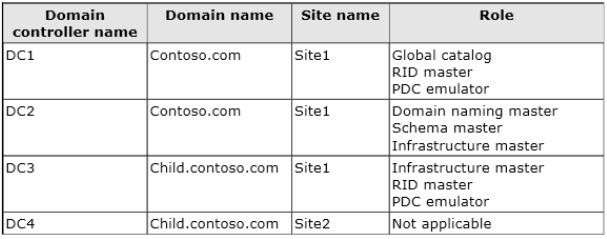
When the link between Site1 and Site2 fails, users fail to log on to Site2.
You need to identify what prevents the users in Site2 from logging on to the child.contoso.com domain.
What should you identify?
The forest contains two domains named contoso.com and child.contoso.com and two sites named Site1 and Site2. The domains and the sites are configured as shown in following table.

When the link between Site1 and Site2 fails, users fail to log on to Site2.
You need to identify what prevents the users in Site2 from logging on to the child.contoso.com domain.
What should you identify?
- AThe placement of the global catalog server
- BThe placement of the infrastructure master
- CThe placement of the domain naming master
- DThe placement of the PDC emulator
Correct Answer:
D
The exhibit shows that Site2 does not have a PDC emulator. This is important because of the close interaction between the RID operations master role and the
PDC emulator role.
The PDC emulator processes password changes from earlier-version clients and other domain controllers on a best-effort basis; handles password authentication requests involving passwords that have recently changed and not yet been replicated throughout the domain; and, by default, synchronizes time. If this domain controller cannot connect to the PDC emulator, this domain controller cannot process authentication requests, it may not be able to synchronize time, and password updates cannot be replicated to it.
The PDC emulator master processes password changes from client computers and replicates these updates to all domain controllers throughout the domain. At any time, there can be only one domain controller acting as the PDC emulator master in each domain in the forest.
D
The exhibit shows that Site2 does not have a PDC emulator. This is important because of the close interaction between the RID operations master role and the
PDC emulator role.
The PDC emulator processes password changes from earlier-version clients and other domain controllers on a best-effort basis; handles password authentication requests involving passwords that have recently changed and not yet been replicated throughout the domain; and, by default, synchronizes time. If this domain controller cannot connect to the PDC emulator, this domain controller cannot process authentication requests, it may not be able to synchronize time, and password updates cannot be replicated to it.
The PDC emulator master processes password changes from client computers and replicates these updates to all domain controllers throughout the domain. At any time, there can be only one domain controller acting as the PDC emulator master in each domain in the forest.
send
light_mode
delete
Question #44
DRAG DROP -
Your network contains an Active Directory domain named contoso.com. The domain contains two servers named Server1 and Server2. Server1 and Server2 run a
Server with a GUI installation of Windows Server 2012 R2.
You remove the Graphical Management Tools and Infrastructure feature on Server2.
You need to restart Server2.
What should you do? (To answer, drag the appropriate tools to the correct statements. Each tool may be used once, more than once, or not at all. You may need to drag the split bar between panes or scroll to view content.)
Select and Place:

Your network contains an Active Directory domain named contoso.com. The domain contains two servers named Server1 and Server2. Server1 and Server2 run a
Server with a GUI installation of Windows Server 2012 R2.
You remove the Graphical Management Tools and Infrastructure feature on Server2.
You need to restart Server2.
What should you do? (To answer, drag the appropriate tools to the correct statements. Each tool may be used once, more than once, or not at all. You may need to drag the split bar between panes or scroll to view content.)
Select and Place:

Correct Answer:

When you uninstall "Server-GUI-Shell" you are left with a "Minimal Server Interface" server. So, File Explorer and IE10 are unavailable, but MMC and Server
Manager work and MMC and Server Manager will allow you to restart server2 either locally or remotely from Server1.
References:
Training Guide: Installing and Configuring Windows Server 2012 R2: Chapter 2: Deploying Servers, p.44

When you uninstall "Server-GUI-Shell" you are left with a "Minimal Server Interface" server. So, File Explorer and IE10 are unavailable, but MMC and Server
Manager work and MMC and Server Manager will allow you to restart server2 either locally or remotely from Server1.
References:
Training Guide: Installing and Configuring Windows Server 2012 R2: Chapter 2: Deploying Servers, p.44
send
light_mode
delete
Question #45
You have a server named Server1 that runs Windows Server 2012 R2.
You plan to create a storage pool that will contain a new volume.
You need to create a new 600-GB volume by using thin provisioning. The new volume must use the parity layout.
What is the minimum number of 256-GB disks required for the storage pool?
You plan to create a storage pool that will contain a new volume.
You need to create a new 600-GB volume by using thin provisioning. The new volume must use the parity layout.
What is the minimum number of 256-GB disks required for the storage pool?
- A2
- B3
- C4
- D5
Correct Answer:
C
It takes 3 discs (minimum) in order to create a storage pool array with parity. If this array were using fixed provisioning, this would not be enough given the 256MB capacity (since only 2/3rds of 256 X 3 - less than 600 - could be used as actual data with the rest being parity bits), but since this array uses thin provisioning, a
600GB volume could technically be set up on a 20GB disc and it would still show as 600GB. (So, essentially, the question really becomes how many drives it takes in a storage pool to create a parity array.)
References:
http://technet.microsoft.com/en-us/library/hh831391.aspx
http://www.ibeast.com/content/tools/RaidCalc/RaidCalc.asp
http://www.raid-calculator.com/default.aspx
https://www.icc-usa.com/raid-calculator
C
It takes 3 discs (minimum) in order to create a storage pool array with parity. If this array were using fixed provisioning, this would not be enough given the 256MB capacity (since only 2/3rds of 256 X 3 - less than 600 - could be used as actual data with the rest being parity bits), but since this array uses thin provisioning, a
600GB volume could technically be set up on a 20GB disc and it would still show as 600GB. (So, essentially, the question really becomes how many drives it takes in a storage pool to create a parity array.)
References:
http://technet.microsoft.com/en-us/library/hh831391.aspx
http://www.ibeast.com/content/tools/RaidCalc/RaidCalc.asp
http://www.raid-calculator.com/default.aspx
https://www.icc-usa.com/raid-calculator
send
light_mode
delete
Question #46
You have a server named Server1 that runs Windows Server 2012 R2.
You plan to use Windows PowerShell Desired State Configuration (DSC) to confirm that the Application Identity service is running on all file servers.
You define the following configuration in the Windows PowerShell Integrated Scripting Environment (ISE):
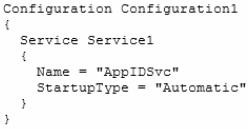
You need to use DSC to configure Server1 as defined in the configuration.
What should you run first?
You plan to use Windows PowerShell Desired State Configuration (DSC) to confirm that the Application Identity service is running on all file servers.
You define the following configuration in the Windows PowerShell Integrated Scripting Environment (ISE):

You need to use DSC to configure Server1 as defined in the configuration.
What should you run first?
- AService1
- BConfiguration1
- CStart DscConfiguration
- DTest-DscConfigu ration
Correct Answer:
B
B
send
light_mode
delete
Question #47
Your network contains an Active Directory domain named contoso.com. The domain contains a server named Server1. Server1 runs Windows Server 2012 R2.
You create a group Managed Service Account named gservice1.
You need to configure a service named Service1 to run as the gservice1 account.
How should you configure Service1?
You create a group Managed Service Account named gservice1.
You need to configure a service named Service1 to run as the gservice1 account.
How should you configure Service1?
- AFrom the Services Console, configure the recovery settings
- BFrom a command prompt, run sc.exe and specify the config parameter
- CFrom Windows PowerShell, run Set-Service and specify the -PassThrough parameter
- DFrom a command prompt, run sc.exe and specify the sdset parameter
Correct Answer:
B
Sc config, Modifies the value of a services entries in the registry and in the Service Control Manager database. obj= {<AccountName> | <ObjectName>}
Specifies a name of an account in which a service will run, or specifies a name of the Windows driver object in which the driver will run. The default setting is
LocalSystem.
password= <Password>
Specifies a password. This is required if an account other than the LocalSystem account is used.
B
Sc config, Modifies the value of a services entries in the registry and in the Service Control Manager database. obj= {<AccountName> | <ObjectName>}
Specifies a name of an account in which a service will run, or specifies a name of the Windows driver object in which the driver will run. The default setting is
LocalSystem.
password= <Password>
Specifies a password. This is required if an account other than the LocalSystem account is used.
send
light_mode
delete
Question #48
HOTSPOT -
You have a server named Server1 that runs Windows Server 2012 R2.
You need to switch Server1 to a Server Core installation of Windows Server 2012 R2.
What command should you run?
To answer, select the appropriate options in the answer area.
Hot Area:

You have a server named Server1 that runs Windows Server 2012 R2.
You need to switch Server1 to a Server Core installation of Windows Server 2012 R2.
What command should you run?
To answer, select the appropriate options in the answer area.
Hot Area:

send
light_mode
delete
Question #49
HOTSPOT -
You have a Hyper-V host named Server1 that runs Windows Server 2008 R2. All of the virtual machines on Server1 use VHDs.
You install the Hyper-V server role on a server named Server2 that runs Windows Server 2012 R2. Server2 has the same hardware configurations as Server1.
You plan to migrate the Hyper-V host from Server1 to Server2 by using the Windows Server Migration Tools.
In the table below, identify what can be migrated by using the Windows Server Migration Tools. Make only one selection in each row. Each correct selection is worth one point.
Hot Area:

You have a Hyper-V host named Server1 that runs Windows Server 2008 R2. All of the virtual machines on Server1 use VHDs.
You install the Hyper-V server role on a server named Server2 that runs Windows Server 2012 R2. Server2 has the same hardware configurations as Server1.
You plan to migrate the Hyper-V host from Server1 to Server2 by using the Windows Server Migration Tools.
In the table below, identify what can be migrated by using the Windows Server Migration Tools. Make only one selection in each row. Each correct selection is worth one point.
Hot Area:

Correct Answer:
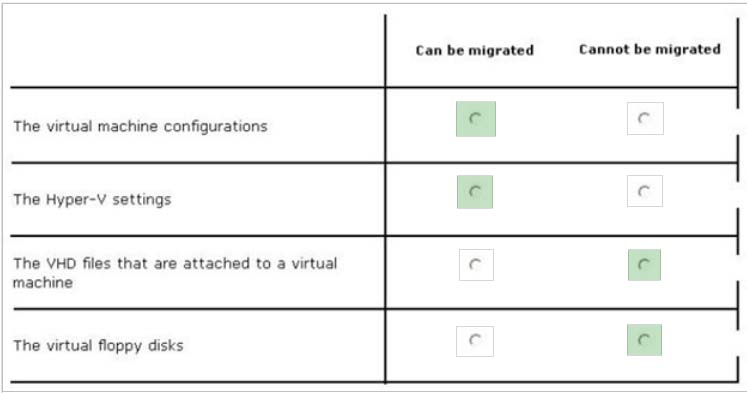
The configurations and settings that can be migrated automatically include:
✑ Most virtual machine configurations. Virtual machines and their data are moved as part of the migration, but some configurations require manual intervention
✑ Hyper-V settings. These include the system-wide settings and the authorization store.
References:
http://technet.microsoft.com/en-us/library/ee849855%28v=WS.10%29.aspx

The configurations and settings that can be migrated automatically include:
✑ Most virtual machine configurations. Virtual machines and their data are moved as part of the migration, but some configurations require manual intervention
✑ Hyper-V settings. These include the system-wide settings and the authorization store.
References:
http://technet.microsoft.com/en-us/library/ee849855%28v=WS.10%29.aspx
send
light_mode
delete
Question #50
DRAG DROP -
You have a server named Server1 that runs Windows Server 2012 R2.
You need to create a new volume on Server1.
The new volume must have the following configurations:
✑ Be stored on a new virtual hard disk
✑ Be assignedthe drive letter G
✑ Have the NTFS file system
In which order should you run the Diskpart commands?
To answer, move all the Diskpart commands from the list of commands to the answer area and arrange them in the correct order.
Select and Place:
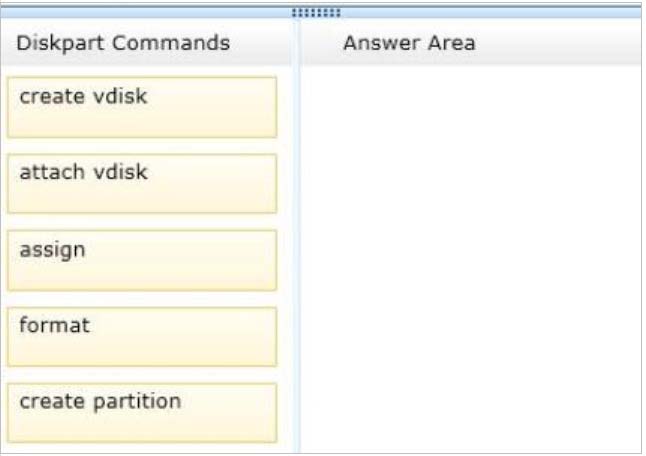
You have a server named Server1 that runs Windows Server 2012 R2.
You need to create a new volume on Server1.
The new volume must have the following configurations:
✑ Be stored on a new virtual hard disk
✑ Be assignedthe drive letter G
✑ Have the NTFS file system
In which order should you run the Diskpart commands?
To answer, move all the Diskpart commands from the list of commands to the answer area and arrange them in the correct order.
Select and Place:

Correct Answer:
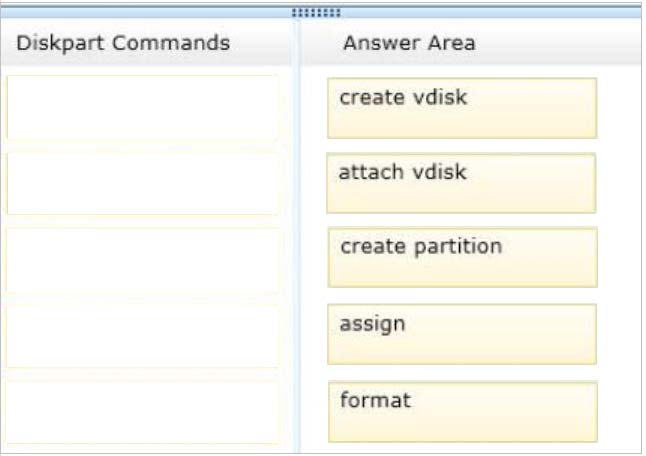
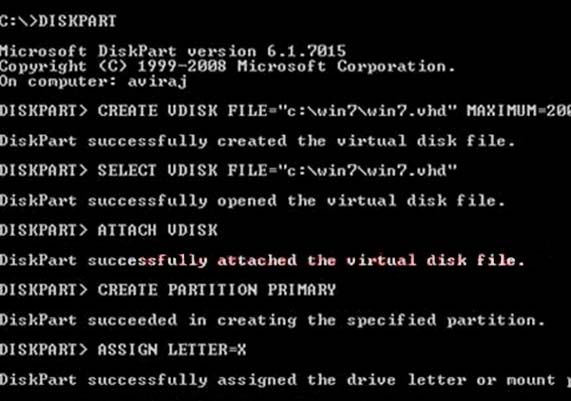
Note: Example:
createvdisk file="C:\vdisks\disk1.vhd" maximum=16000
attachvdisk
create partition primary
assignletter=g
format
References:
http://technet.microsoft.com/en-us/library/gg252576.aspx
http://technet.microsoft.com/en-us/library/hh831487.aspx


Note: Example:
createvdisk file="C:\vdisks\disk1.vhd" maximum=16000
attachvdisk
create partition primary
assignletter=g
format
References:
http://technet.microsoft.com/en-us/library/gg252576.aspx
http://technet.microsoft.com/en-us/library/hh831487.aspx
send
light_mode
delete
All Pages

